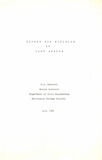Timber for building in East Africa
Abstract
1. TIMBER SPECIES OF EAST AFRICA
These fall into four groups: indigenous and exotic; each divided
into Broad leaved (or hardwood)species and Conifers (or softwood) species.
Indigenous Broad leaved species
These comprise the majority of the species and occur over the whole
of East Africa though they are of particular economic importance to
Uganda and Tanzania in the absence of large supplies of conifers. This
group includes such species as Mvule, E.A. Camphor, African Mahogany,
Muninga and many others most of which are more used for joinery than
building though certain properties such as a locally favourable supply
and durability may encourage their use in some circumstances. These
timbers occur in natural forests though there are a few plantations.
Indigenous Conifers
The two species~ Pedo and Cedar9 are declining in importance in
Kenya as they become worked outo Both grow on the slopes of the higher
mountains mainly in Kenya and N. Tanzania. Cedar may be classified as a
scarce timber in large sizes but Podo is still available in Kenya and is
fairly common in No Tanzaniao
Exotic Broad leaved species
The main species are ubiquitous ~~ligna gum and grevillea from
Australia. Other eucalypts are also grown in plantations and there is
some teak in Tanzaniao The eucalypts have mainly been used for poles
and not great deal in converted form in construction though there is no
reason why this should not be done.
Exotic Conifers
These include Cypress and Pine and are grown extensively in the
Kenya Highlands and parts of Tanzania. Cypress is the main construction
timber over much of East Africa and this market will be shared with
Pine as increasing quantities of the latter become available.
Publisher
University Of Nairobi
Rights
Attribution-NonCommercial-NoDerivs 3.0 United StatesUsage Rights
http://creativecommons.org/licenses/by-nc-nd/3.0/us/Collections
- Research Reports [210]
The following license files are associated with this item:


